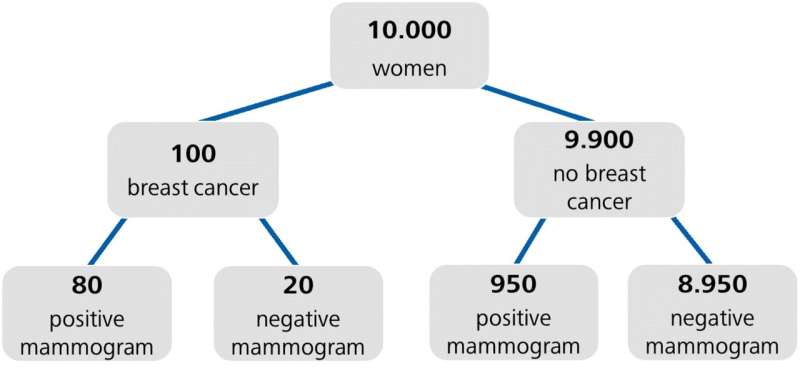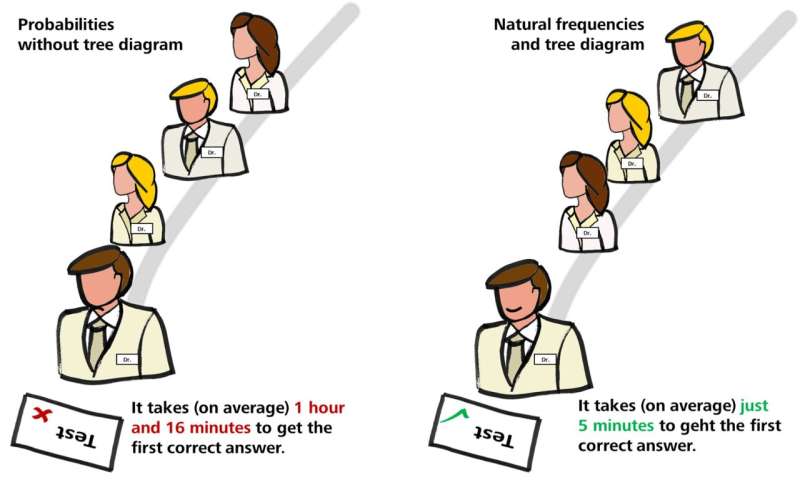Faster and more accurate diagnosis with natural frequency trees

Researchers in the field of mathematics education at the University of Regensburg, together with medical education researchers at the LMU University Hospital of Munich, have found that medical diagnoses can be made more accurately and quickly with the help of natural frequencies and natural frequency trees. The researchers explain their findings in a recently published article in Advances in Health Sciences Education.
Interpreting statistical statements correctly is quite complex, as many examples show. In October 2020, U.S. President Donald Trump announced that 85% of people who wear a mask will be infected with coronavirus. "This statement was based on a confusion of conditional probabilities," says Dr. Karin Binder. "In fact, the former U.S. president confused the two conditional probabilities: 'How likely is it that people wearing a mask will be infected with coronavirus?' vs. 'How likely is it that a coronavirus infected person wore a mask?'"
Similar confusion can be observed among medical students and even physicians. Such misinterpretations—and how to prevent them—have been investigated by Dr. Karin Binder and Professor Dr. Stefan Krauss from the University of Regensburg (Mathematics Education) together with Professor Dr. Ralf Schmidmaier and Dr. Leah Braun from LMU University Hospital of Munich.
In order to examine this effect, the scientists presented their participants the following information on mammography screening for breast cancer detection: A woman is asymptomatic and would like to participate in routine screening. In her age group, the probability of breast cancer is 1%. Mammography screening will detect the disease with an 80% probability if the woman has breast cancer. On the other hand, if the woman is completely healthy, she has about a 9.6% chance of falsely receiving a positive test result. Now, medical students in the study were asked to answer the following question: How likely is it that a woman actually has breast cancer if she receives a positive result on her mammogram? The correct solution can be calculated using Bayes' formula, for example, and is just under 8%.

As it was already known from previous studies, it appeared that medical students understand statistical information better if it is communicated via so-called natural frequencies (e.g., "Eighty out of 100 women with breast cancer receive a positive result in mammography") instead of probabilities (e.g., "80% of women with breast cancer receive a positive result in mammography"). Additional visualization with frequency trees (see figure) can also help medical students to find the correct solution: 80 women with breast cancer and 950 women without breast cancer receive a positive test result—this yields in sum 1,030 women with a positive test result on mammography. However, out of these 1,030 women, only 80 have the disease, which corresponds to the percentage of about 8%.
In their recently published article in Advances in Health Sciences Education, the researchers demonstrate that natural frequencies and frequency trees not only lead to a higher proportion of correct diagnoses, but that these could be made more quickly. Since both correctness and speed of diagnosis are extremely important in a physician's daily routine, the proportion of correct answers and the amount of time required to answer each task were combined to form the measure "diagnostic efficiency." The calculated diagnostic efficiency can be interpreted as follows:
"Imagine two queues of medical students," says Karin Binder. In the left queue, students have to solve the task in probabilities and without a tree. The students queueing on the right receive the information in the form of natural frequencies and within a tree diagram. Now, the students have to solve the task one after the other. As soon as they have written down an answer, it is the next student's turn... until you get the first correct answer.
In the variant with probabilities without a tree, this takes over one hour and 16 minutes: On average, only every 17th medical student can provide a correct solution for the task. In the variant with natural frequencies and the tree diagram, the first correct answer is given after about five minutes, because about 60% of the participants solve the task correctly and need usually less than three minutes to do so. The scientists consider their findings to be helpful in the further development of medical curricula and could lead to an improvement in the training of medical students.
More information: Karin Binder et al. Natural frequency trees improve diagnostic efficiency in Bayesian reasoning, Advances in Health Sciences Education (2021). DOI: 10.1007/s10459-020-10025-8


















